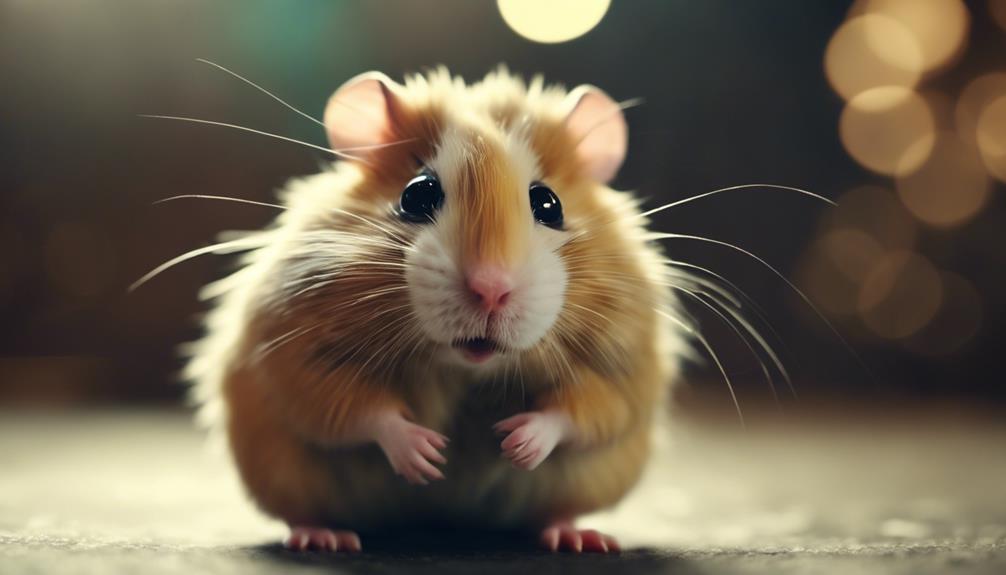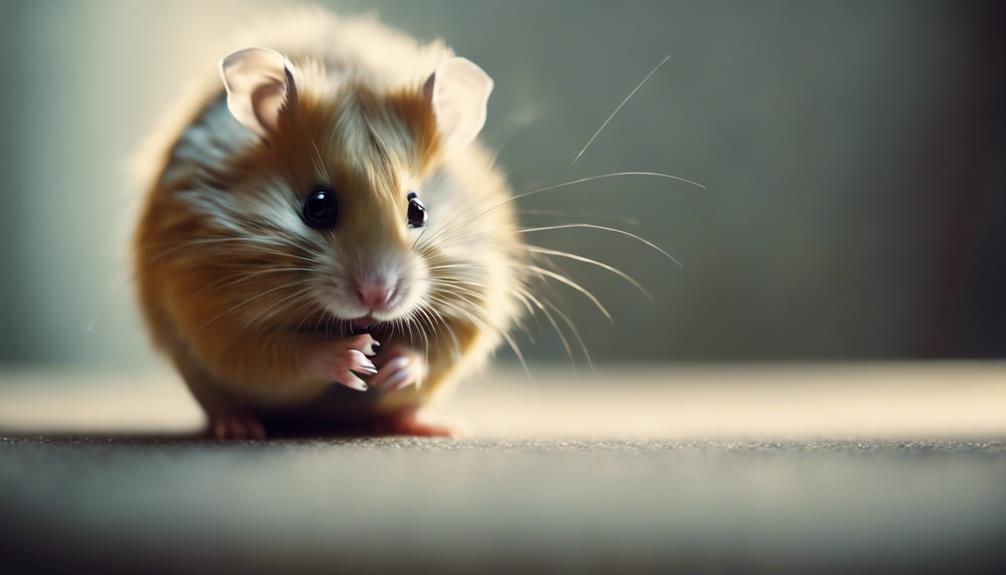How to Understand Your Hamster's Body Language

Understanding Your Hamster's Body Language:
Learn to decipher the silent messages in every whisker twitch and tail flick by observing closely and with an open heart.
Unravel the mysteries within these subtle movements to forge a deep bond with your furry friend.
Key Body Parts to Observe
When observing your hamster's body language, the key body parts to focus on are its ears, eyes, and posture. These elements serve as windows into the inner world of your tiny companion, offering insights that go beyond words.
The subtle movements of its ears, such as twitching, can convey a range of emotions from curiosity to agitation. Likewise, the eyes, with their bright sparkle or soft gaze, reveal the hamster's mood with clarity. Lastly, the posture, whether it stands tall or hunches low, speaks volumes about its comfort and state of mind.
In addition to these key areas, paw tapping is another behavior to watch out for. When a hamster engages in paw tapping, it may indicate a moment of contemplation or even a playful disposition. Recognizing these nuances in body language allows you to build a deeper connection with your hamster, fostering a bond based on understanding and mutual respect. By paying attention to these subtle cues, you honor your hamster's freedom to express itself in its unique and beautiful way.
Signs of Contentment and Happiness
In the subtle dance of hamster body language, signs of contentment and happiness manifest through a symphony of gestures and expressions. Play behavior is a clear indicator of a happy hamster. When your furry friend engages in activities like running on their wheel, exploring their environment, or even performing acrobatics, it's a sign that they're content and enjoying themselves.
Additionally, observing their sleeping patterns can offer insights into their emotional state. A hamster that curls up comfortably in their nesting area, with a relaxed body posture and gentle breathing, is likely feeling safe and content.
Contentment in hamsters can also be seen through their general demeanor – a happy hamster will display a curious and alert attitude, with bright, sparkling eyes and a relaxed body. They may also groom themselves more frequently, another positive sign. Understanding these subtle cues will help you foster a nurturing environment where your hamster can thrive and lead a joyful, fulfilling life.
Indications of Fear or Stress

Behold the subtle tremors of unease that ripple through a hamster's demeanor, revealing the delicate nuances of fear and stress in their body language. When a hamster is experiencing fear or stress, their breathing patterns may become rapid and shallow, and their body postures may appear tense or hunched. These physical manifestations are crucial indicators of their emotional state, offering valuable insights into their well-being.
In addition to changes in breathing and body postures, observe any behavioral changes that may signal fear or stress in your hamster. They may become more withdrawn, exhibit excessive grooming, or display erratic movements. These shifts in behavior can provide crucial clues about their mental state and shouldn't be overlooked.
Moreover, pay attention to any vocal cues your hamster may give off when feeling fearful or stressed. While this aspect will be discussed in detail in the next subtopic, 'Communication Through Vocalizations,' it's important to remember that vocalizations can also be a key indicator of their emotional distress. By being attuned to these subtle signs, you can better understand and support your hamster during moments of fear or stress.
Communication Through Vocalizations
As one observes the subtle shifts in a hamster's vocalizations, a rich tapestry of communication unfolds, offering profound insights into their emotional world. Hamsters express themselves through a variety of vocal cues, each carrying its own significance:
- Understanding Squeaks: Hamsters often emit high-pitched squeaks when they're excited or in distress. Pay attention to the context to decipher their message accurately.
- Chirps: Soft, melodic chirps are a sign of contentment and happiness in hamsters. These gentle sounds indicate a sense of comfort and relaxation.
- Interpreting Bruxing: Bruxing refers to the grinding of teeth, often heard when a hamster is feeling content and secure. This soothing sound is akin to a cat's purring.
- Grooming Sounds: Hamsters make subtle grooming noises when they're cleaning themselves. These quiet, rhythmic sounds show that your furry friend is engaged in self-care and feeling at ease.
Understanding Tail Movements

The language of a hamster's tail can be as telling as a whispered secret in the wind.
Tail wagging isn't merely an act of whimsy but a form of expression, conveying everything from excitement to agitation.
On the other hand, when a hamster puffs its tail, it's akin to a warning sign, signaling discomfort or displeasure.
Tail Wagging Meaning
Observing the subtle movements of your hamster's tail can provide valuable insights into their current emotions and intentions. The way a hamster wags its tail can convey a range of messages, offering a window into their inner world. Here are some key interpretations to keep in mind:
- Tail thumping: This behavior often signifies a dominance display as your hamster asserts itself.
- Tail curling: When your hamster curls its tail, it's typically a sign of curiosity, showing that they're engaged and exploring their surroundings.
- Rapid tail wagging: An excited or agitated hamster may exhibit quick, back-and-forth tail movements.
- Slow, relaxed tail swaying: A hamster with a gently swaying tail is likely calm and content in its environment.
Tail Puffing Indication
Behold the subtle yet telling gesture of a hamster's tail puffing, a movement that unveils a deeper layer of their emotions and communication. Interpreting tail puffing is akin to deciphering a silent language, where each flicker and swell carries significance.
When a hamster's tail puffs up, it can signify a range of behavioral cues. It might indicate agitation, fear, or a sense of defensiveness, urging the observer to approach with caution and empathy. Understanding these nuanced signals enhances the bond between human and hamster, fostering a relationship built on mutual respect and comprehension.
The Importance of Eye Expressions
The eyes of a hamster speak volumes, revealing a plethora of emotions through their subtle movements. From the dilation of their pupils to the frequency of their blinks, these tiny creatures convey their level of interest and relaxation.
Understanding these eye expressions is key to deciphering your hamster's feelings and building a stronger bond with your furry friend.
Eye Movements Convey Emotions
With a simple glance, a hamster's eyes can reveal a wealth of emotions, serving as a crucial tool for understanding their feelings and intentions. Hamsters use their eyes to communicate subtle messages, making eye contact an essential aspect of their interactions.
Here are some key points to consider:
- Wide-eyed Stare: Indicates alertness and curiosity.
- Half-closed Eyes: Reflect relaxation and contentment.
- Rapid Blinking: Can signify nervousness or discomfort.
- Avoiding Eye Contact: Suggests fear or submission.
Pupil Size Indicates Interest
In deciphering a hamster's emotions, the fluctuation in their pupil size serves as a pivotal indicator of interest and engagement. Body language interpretation plays a crucial role in understanding these small creatures, and pupil dilation is a key aspect to consider.
When a hamster is intrigued or focused, their pupils tend to dilate, indicating heightened attention and emotional investment. Observing these emotional cues through changes in eye size can provide valuable insights into your hamster's feelings and level of interest in their surroundings.
Blinking Signifies Relaxation
Blinking by a hamster indicates a state of relaxation and comfort, serving as a crucial aspect of their eye expressions. Hamsters tend to blink more frequently when they're in a relaxed environment, free from stress or danger. This subtle yet significant behavior can provide valuable insights into your furry friend's well-being and emotional state.
Understanding the blinking frequency of your hamster can help you create a safe and nurturing environment for them to thrive. Additionally, maintaining gentle eye contact with your hamster can help build trust and strengthen your bond with them. Observing their blinking patterns during these interactions can further deepen your understanding of their feelings and preferences.
- Hamsters blink more when relaxed
- Blinking frequency indicates emotional well-being
- Eye contact fosters trust
- Observing blinking patterns enhances understanding
Interpreting Grooming Behavior
Observing a hamster's grooming behavior provides valuable insights into their well-being and emotional state. Grooming habits aren't merely about cleanliness for these tiny creatures; they're also a form of self-expression. When a hamster meticulously grooms itself, it signifies contentment and a sense of security in its environment. The meticulous nature of their grooming habits reflects the meticulous care they take in managing their surroundings.
Through grooming, hamsters also communicate subtle body language cues. A hamster that grooms another is displaying affection and bonding with its cage mate. Conversely, a hamster that excessively grooms itself or displays changes in grooming patterns may be experiencing stress or discomfort. Understanding these nuances in grooming behavior allows for a deeper connection with your furry companion.
In essence, interpreting a hamster's grooming behavior is akin to deciphering a silent language of care and emotion. By paying attention to these grooming habits and body language cues, one can foster a harmonious and enriching relationship with their hamster.
Responding to Aggression or Discomfort

Interpreting a hamster's grooming behavior provides a window into their well-being and emotional state, and when faced with signs of aggression or discomfort, swift and empathetic responses are crucial for fostering a trusting bond with your tiny companion. Understanding how to address defensive behavior and anger in hamsters is essential for maintaining a harmonious relationship.
Here are some key points to consider when dealing with aggression or discomfort:
- Stay Calm: Maintaining a composed demeanor can help de-escalate the situation and prevent further stress.
- Give Space: If your hamster is showing signs of aggression, it's important to give them space to calm down and feel safe.
- Avoid Punishment: Punishing a hamster for displaying defensive behavior can lead to increased fear and aggression.
- Seek Professional Advice: If your hamster's aggression persists or escalates, consulting a veterinarian or animal behaviorist is advisable to address the issue effectively.
Frequently Asked Questions
How Can I Tell if My Hamster Is Feeling Lonely or in Need of Social Interaction?
Observing a hamster's behavior is crucial to understand its need for social interactions. Loneliness indicators like decreased activity or excessive grooming may suggest the desire for companionship. Enrichment activities and quality time can greatly benefit their well-being.
What Should I Do if My Hamster Displays Sudden Changes in Behavior or Aggression Towards Me?
When a hamster displays sudden behavior changes or aggression, it's crucial to stay calm and avoid reacting in a way that could escalate the situation. Bonding exercises and social play can help build trust and alleviate stress.
Are There Specific Body Language Cues That Indicate My Hamster Is in Pain or Unwell?
Observing a hamster's body language can reveal pain indicators or wellbeing cues. Communication signals, like agitated movements or excessive grooming, may signify distress. Loneliness signs, such as decreased activity or appetite, could also suggest an unwell hamster.
How Can I Help My Hamster Feel More Comfortable and Secure in Its Environment?
To help a hamster feel more comfortable and secure in its environment, bonding techniques and creating a routine are key. By spending quality time together and establishing a predictable schedule, a deep connection can be forged, fostering trust and peace.
Is There a Way to Teach My Hamster to Communicate Its Needs More Effectively Through Body Language?
Teaching a hamster to communicate effectively through body language involves training methods that focus on recognizing behavioral cues. Bonding exercises and communication strategies can help foster a strong relationship, enhancing the understanding between the pet and owner.









